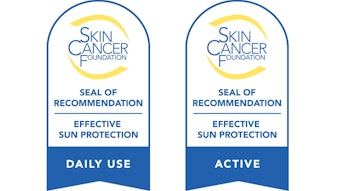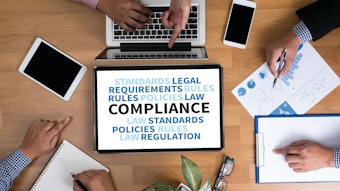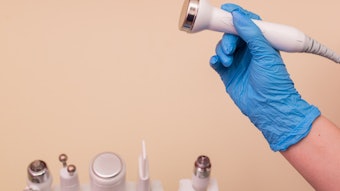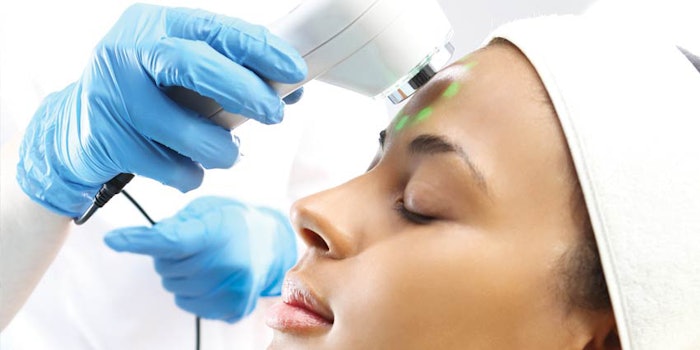
Using esthetic devices within the treatment room can improve client results and your bottom line if chosen correctly. There are many factors that are important to keep in mind when deciding what works for your business. It can be easy to get caught up in the latest marketing hype and make an expensive mistake. In my 20 years in the industry, I have made some major purchases that are now sitting in a closet. Most of them were impulse buys—I thought it would improve my service offering, only to find out that the clients did not care about the device or there was no significant result from using the device. To help you avoid the same mistakes that I have made, let’s take a different approach to choosing devices for your spa, and this approach starts with determining if you need the device. After identifying your needs, determining the financials, its efficacy and scope of practice will help you make an educated decision to avoid long-term issues.
1. Do I Need It?
The first question that should be asked is if you really need this device? Is this part of your strategic plan?
Every small business owner should have a strategic plan that includes marketing and financial planning to help direct the growth of the business. Even if you are a one room independent contractor, you need some direction on where you are going.
Before your eyes glaze over at the thought of developing this type of a plan, there is a rather simple way to do it. It is worth your time to put some thought into why you are working the way you are. The idea is to work smarter, not harder. With social media marketing and other digital data resources, getting an idea of your demographics and target customer is easier than ever. Here is a simple formula that you can use to define a simple business strategy.
Objective. Clearly define the mission of your business. Why does your business exist? For example, “To be the leader in providing skin care services for people who are suffering from sensitized skin conditions and are concerned with aging skin within the greater metro area.”
Strategy. Create a general strategy to support your mission. What is the plan to achieve this goal? Be specific on your target market. For example, “To position our skin care services as the most expert, personalized service available; to target adults age 30-60 with an annual income of 55K-150K.”
Tactics. What are the specific steps that will be taken to achieve this? Be as detailed as possible. For example, “Create a social media campaign targeting our market through Facebook ads, Pinterest content and a blog. Provide press releases to local media outlets X and Y. Create a webpage that has a call to action section with usable content to collect an email list. Create a list of current clients who would be willing to post testimonials about services. Design services that provide measurable results based on current skin science. Provide access to professional skin care products that are unique to the business and are proven to provide results.”
Now that you have a quick overall plan, it is time to narrow down all your choices which includes equipment. Take the same outline and focus on the core of your business—skin care treatment. Below is an example.
Objective. To treat adults with sensitized skin and aging skin conditions.
Strategy. Identify the services (and their products) that can treat sensitized and aging skin with minimal side effects. Make sure price points for services and products fall within the demographic range.
Tactic. Find the best modalities to treat these conditions based on skin science. To determine this, look closely at which skin functions to target and match them to modalities that are known to impact them. For example, sensitive conditions are always impacted by the health of the skin barrier. This can take some time if you are inexperienced. Reach out to fellow experienced estheticians for help if you are unsure. See Treating Sensitive and Aging Skin for a table of choosing devices and products associated with the conditions you treat.
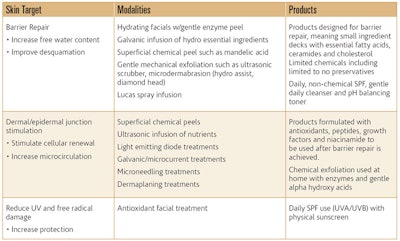 After you have an idea of the main areas that must be addressed within the skin, then you can start to formulate a list of products and devices needed to achieve this. Based on the sensitive and aging skin example, devices available would include: galvanic current, ultrasonic scrubber, microdermabrasion, Lucas spray, ultrasonic/ ultrasound device, LED device, microcurrent, microneedling and dermaplaning.
After you have an idea of the main areas that must be addressed within the skin, then you can start to formulate a list of products and devices needed to achieve this. Based on the sensitive and aging skin example, devices available would include: galvanic current, ultrasonic scrubber, microdermabrasion, Lucas spray, ultrasonic/ ultrasound device, LED device, microcurrent, microneedling and dermaplaning.This would be the same procedure for listing your potential products as well.
As you can see, this is an extensive and expensive list. Not all the devices are needed to meet your objectives, so how do you decide from here? The next steps are determining if the devices on the list are in scope, what the cost is, and do the devices perform as advertised.
2. Can I Use It?
This is the number one question that most estheticians and business owners start with. State scope of practice has a huge impact on how your business will function as well as the costs associated with utilizing devices. Unfortunately, many states are not keeping up with technology, which makes it hard to determine if something is within scope. Getting an official interpretation of rules from a state board is not always the best course of action either. So, the key things that you need to know surround state scope and insurance.
State scope. If your state’s statute clearly defines the esthetic scope as working on the stratum corneum only, chances are that something like microneedling, LED, ultrasound and possibly microcurrent will be out of scope. Rules are created to address the specific devices and U.S. Food and Drug Administration classifications accepted by the board. It is a complicated process to update rules, which leaves a lot of new technology in the grey area. Knowing this, you can make an educated decision in whether you want to take the risk. Regarding multifunctional devices, if one component of the device is out of scope, the whole device can be flagged as being out of scope as well. Just remember to look at your statute as well as rules. When in doubt, get some help.
Insurance. Will your insurance cover the device? If your insurance policy states that anything out of scope will not be covered, try to get your modalities included in the policy. If you are using a basic policy shared by a group, you will not be able to negotiate this. It would be valuable to explore the option of an additional policy to fill the gaps if you can. Be aware that just because an insurance policy says that it will cover you in the event of a mishap, does not mean that it 100% will.
3. Can I Afford It?
The total cost of a device includes more than the sales price. It is important to determine any additional costs that you may have such as: increased insurance, treatment room modifications (if any), training costs, marketing costs and cost per use. Cost per use is essential to help determine the price you will charge for the service. This is important to know when determining if you can offer this service to your target market.
4. Does It Work?
This is an important question. The marketing surrounding a device can be so compelling that you forget to look at the results. There can be lack of documented results to make a good decision. If that is the case, it is best to wait and get additional information. When looking for efficacy, look at skin science, consistent outcome and client safety, as explained below.
Skin science. How does the device work on the skin? If your device manufacturer cannot answer this, then move on. If the device is claiming to firm the skin but also notes it only works on the stratum corneum, then this is contrary to known skin science. Firming requires energy that works on the dermis (collagen/elastin production) and possibly muscle function (faradic current). If the claim is that it can stimulate skin firmness by working on the epidermis, that is another matter. This could be something as simple as microcurrent stimulating cell communication or micro wounds from a .5mm microneedling device.
Just realize that something that promises quick results requires higher energy and usually is painful for the client. This is where the medical field comes in; there are not many medical interventions that do not cause discomfort. Radio frequency is an example of this, as the known level of energy needed to get the dermis to the correct temperature for collagen production is not a comfortable process. Keep this in mind when researching the device that you want to purchase.
Consistent outcome. Are there documented consistent results? This can be provided in the form of case studies, observational scientific studies and longevity of the device. If the device has been around for five years or more there should be a consensus from estheticians in the market that the device works or doesn’t. For any large device purchase, there needs to be some evidence that it is going to work consistently for your spa. The burden of that information does not fall on you. Your manufacturer needs to present it, and you can verify it the best way you can.
Client safety. Safety data should be available for any device you purchase. Ideally it should be provided by your manufacturer. Questions to ask are:
- Do you have any safety data,
- Has there been any injury claims, and
- Do you provide training to ensure safe use?
Many insurance policies also require that you are fully trained in the device before they will insure it.
Putting It All Together
Choosing a device is an involved process and should not be approached impulsively. If you are wanting to buy at a show, make sure that you have done your homework before you go. Try to keep to your budget, and do not be afraid to ask the hard questions. Keep in mind, the burden of working within your scope of practice is on you. An ethical manufacturer would ideally do some due diligence before marketing the device to the esthetics profession, but do not rely on their information alone.
Before you write that check make sure you have: your overall strategic plan, analyzed modalities needed to achieve results, your scope of practice and price range of services. From there you can get further information from the manufacturer about safety, cost per use and training costs. Taking these simple steps will save you money in the long run.

